|
|
|
|
| 1-4 , 20-45 , |
| Stefan Feld |
| Julien Delval
Harald Lieske |
| alea |
| 2016-07-29 |
| Bart De Cock (be_com4) |
| Boardgamegeek | 191977 |
| 2,56/5 |
|
|
|
|
|
If you are reading these rules for the first time, ignore the text along the right hand side. These rules serve as a summary to help you quickly familiarize yourself with the game.
Show
→ summary only
→ detailed version only
→ both summary and detailed version

The Castles of Burgundy - The Card Game
The Loire Valley in the 15th century. As influential
sovereigns, players grow their estates through
strategic trade and commerce.
Playing cards that serve as “dice” show possible
actions, but players make the final decisions.
Will you trade or buy livestock, build city buildings
or invest in scientific progress? There are
many paths to prosperity and prestige!
The winner is the player with the most victory
points at the end of the game.
Clarification about the implementation on Yucata:
- All points are immediately awarded during the game instead of at the end.
Game Components
114 action cards (with red backs):
12 castles (dark green)
12 mines (gray)
12 cloisters (violet)
18 knowledge (yellow)
18 ships (blue)
18 pastures (light green)
24 buildings (beige, 3x 8 types)
126 additional cards:
6 x3 types of goods
5 x4 different animals
7 bonuses (marked “1.”)
4 bonuses (called “All 7 types”)
6 displays (1-6)
5 rounds (A-E)
1 start player
8 1 victory point
7 2 victory points
22 workers
16 silver
4 x3 types of player cards (projects, estate and storage)
Setup
Each player gets:
- 1 storage, 1 estate and 1 project card
- 1 good + 1 animal
- 1 silver
Place remaining good
and animal cards in
2 open piles each
Distribute workers
(0-2, depending on
turn order)
Place display cards in
rows from 1-6
Place bonus cards
(marked “1.”) above
display
Place the “All 7
types” bonus cards in
a pile, in decreasing
order
Place victory point
cards
Place round cards in
in increasing order
Shuffle the action
cards and deal 6 to
each player (leave
cards face down)
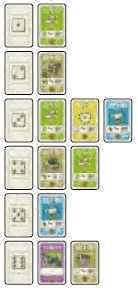
With 2/3/4 players,
place 7/10/13 action
cards face up in the
display
Possible starting display with 3 players:
Each player receives the following cards:
-
one project, one estate, and one storage.
Players place the cards on the table in front of
them, as shown in the side bar.
-
one good + one animal (randomly picked),
+ one silver. Each player places these three
cards in their storage (i.e. face up below their
storage card).
The remaining good cards are shuffled
and placed face up in two equal piles
at the edge of the table. Do the same
with the remaining animal cards.
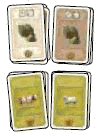
The silver and the worker cards are also placed
in two piles at the edge of the table.
The youngest player is the starting player
and places the start player card face up
(i.e. without question marks) besides their
estate card. The next two players to the
left each receive 1 worker card from the
supply pile, and the last player receives 2 worker cards. Players place these cards in their storage.
The display cards are placed from 1 to 6
in rows in the middle of the table. Each
round, players will place cards beside the
display cards.
The 7 bonus cards (marked “1.”) are
placed above the display cards, slightly
fanned.
The 4 bonus cards (“All 7 types”) are
placed above the display cards, in one
pile (with the 4 on top, then 3, 2, 1).
Note: If there are fewer than 4 players, use
only these bonus cards: 3 players: 4 + 2 + 1; 2 players:
3 + 1.
The 15 victory point cards are placed
in one pile at the edge of the table.
The 5 round cards (A-E) are placed
also in one pile (above A, then B, C,
D, E).
The 114 action cards (with red backs) are
shuffled and placed in one pile below the display.
Each player receives 6 cards and puts them on
the table without looking at them. This is the
supply of “dice” for the first round (see below).
Depending on the number of players, place
the following number of action cards face up
beside the display cards:
- 2 pl. - 7 cards
- 3 pl. - 10 cards
- 4 pl. - 13 cards
Placing the 7, 10 or 13 action cards: The first 6
cards are placed one at a time from the top row
to the bottom row. With 4 players do the same
with the next 6 cards (i.e. 12 cards total). The
last card is placed according to its die number.
For example: If the last card is a 6, place it beside the
display-6.
With 3 players the last 4 cards are placed in this way
Game Play
Game Play
5 rounds, with 6 turns in each
In turn order each player discards one of two action cards and performs – using the number of the die on it – one of six possible actions

Look only at the die!
The game is played over five rounds (A to E).
Each round consists of six turns.
In clockwise order, beginning with the starting
player, each player picks the top two action cards
from their card pile and looks at the die only on
the two cards (all other information on these two
action cards is ignored!).
The starting player places one of the two cards
face up on a common discard pile and using the
number indicated on the card performs one of six
possible actions (see below).
Then it is the next player’s turn. This player also
places one of the two cards face up on the discard
pile and performs an action, etc. When each
player has taken a turn, a new turn begins. Each
player draws the next action card, so they again
have two cards in their hand. Play continues in
this way until the last, sixth turn of each round,
when all players have played their last action
card.
It is necessary to play a die, i.e. an action card,
for each action. The six different possible actions
are explained on the next three pages.
Take 1 card
Die number matches a row number
Place card under your project card
Note: No more than 3 projects are allowed at one time!
Action 1: “Take a card from the display”
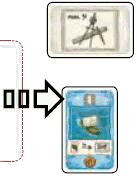
The die number on the discarded action card
indicates from which display row
(1 through 6) you may take a card.
Cards taken from the display
are always placed below your
project card. No more than
three cards can be placed under
a player’s project card.
Note: If there are already 3 cards under
your project card, you must discard one of the three
before placing a new card there.
Place 1 project
Die number matches a project number
Place card under your estate card

At game end the three
buildings on the left will
earn 3 victory points, the
three pastures in the middle
earn 4 and the three cloisters
on the right earn
6 victory points.
Action 2: “Place a project in your estate”
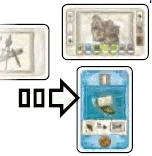
The die number on the discarded action card
must match the die number
on one of the cards from your
projects. Take one project card
with the matching number
from your projects and move it
into your estate (i.e. below your
estate card).
Identical types of cards in your estate are piled
one on top of the other; different types of cards
are placed next to each other.
The goal is to have 3 of the same type of card in
your estate at the end of the game, entitling you
to the corresponding number of victory points
(shown at the bottom of the cards).
When placing a project in your estate, you
immediately gain one bonus, as explained further.
Sell goods
The die number indicates the type of good that may be sold
Take 1 silver for each good sold
Seller also receives the (face down) start player card
Action 3: “Sell goods”
The die number on the discarded action card
determines which type of good (light, medium
or dark brown) you may sell. Move all the good
cards with the matching number from your storage
to the right side of your estate card, so that
the victory points can still be seen.
In addition, take one silver card from your supply
for each good card sold.
Finally, the player who sells goods
receives the starting player card,
keeping it face down (i.e. with the
question marks showing).
Note: When selling goods, a player
always receives the start player card
(face down). This also applies if
someone uses a ‘warehouse’ (see
below).
Important! Turn order of the current round does
not change by this.
Restock workers to 2
+ 1 or 2 worker cards (die number does not matter!)
Action 4: “Restock workers to 2 cards”
Regardless of which die number is on
the action card, restock your worker
cards to 2 only. Thus, if you have one
worker card, take one from the supply,
if you have zero, take two.
Take 1 silver
+ 1 silver (die number does not matter!)
Action 5: “Take 1 silver”
Regardless of which die number is on
the action card, take one silver from
the supply
Convert workers/silver into victory points
Discard any number of workers/silver and gain 1 victory point per 3 cards (die number does not matter!)
Action 6: “Convert workers and/or silver into victory points”
Regardless of which die number is on the action
card, convert worker and/or silver cards into
victory points.
Put any number of worker and/or silver cards
back into the supply, divide the total number of
cards returned by 3, and take the resulting number
of victory point cards. Place these to the left
of your estate card, so that the victory points can
still be seen.
Example: Tom returns 5 workers and 1 silver to the
supply and takes a 2-victory point card from the supply.
The workers
With each worker
card the die number
can be changed ± 1
(and from 6 to 1, or
vice versa)
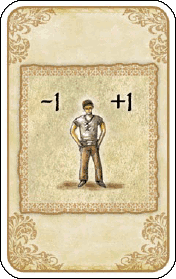
After discarding an action card, the player can
place a worker card back to the supply to change
the number of the discarded die
up or down by 1. Changing from
1 to 6 or from 6 to 1 is possible
and costs one worker card.
Several worker cards may be used
to change a die number by more
than 1.
Example: Megan can change a 2 to a 6 using two
worker cards.
The silver
Once per turn a player may buy 3 action cards for 3 silver
Use one of the cards:
-
Either as a new
project
-
or as another action
card (using the die)
Attention! Don´t
forget your regular
action!
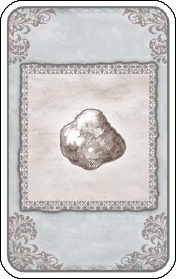
In addition to your normal action,
once during your turn you can “buy”
3 new action cards from the deck by
“paying” 3 silver cards to the supply.
This can happen before, during or after
performing your normal action.
Choose only one of the newly purchased cards
to:
-
Either place it as a new project under your
project card (remember the 3 card limit!).
-
Or use it as action, by discarding it and using
the die on it to take one additional action.
In either case, put the remaining two newly
purchased cards on the discard pile, never to be
used!
Example: Ivy discards one of the two cards in her
hand and places a castle in her estate. Then she pays
3 silver cards to buy the top three cards from the deck
(during the middle of her castle function). She selects
another castle and places it as a new project. She then
performs the function of the previously placed castle
and places the just bought castle into her estate. Finally,
she uses the function of this newly placed castle to take
another castle from the display and place it under her
project card.
Additional important rules for placing projects:
Estate cards cannot be moved again

The first triple of a
type generates the
matching bonus card
(= 1 victory point)
Each triple generates
one of the current
round bonuses
All 7 types of cards
in the estate generates
an “All 7 types”
bonus card (4/3/2/1
victory points)
Fourth card of a type
starts a new triple
- Once you have placed cards in your estate you may not move them again.
-
The first player to complete a triple receives the
matching bonus card from the supply (worth 1
victory point at game end). The player places it
to the left side of the estate card, so the victory
point remains visible.
-
The player receives one of the current round bonuses when completing a triple.
In addition, any player completing a triple receives one of the current round bonuses of their choice.
For instance in round A you can choose to take either
3 victory points, 2 goods, 2 animals, 3 silver, or 3
workers. In round D you can either choose 2 silver, 2
workers, or 1 worker + 1 silver.
-
The first player who has cards of all seven
colors at any point in their estate immediately receives the
top most card from the “All 7 types” bonus
card deck (i.e. 4, 3, 2, or 1 victory point(s) at
game end). The player places it on the left side
of the estate card so the victory points remain
visible.
To explain and illustrate: It does not matter whether a Cloister was assigned to another type or not!
For instance, the first player in a 3-player game receives
the card with the 4, the second receives the 2 and the
third receives the 1.
-
When placing the fourth card of a type in your
estate, start a new triple with it.
(It could also score at game end, if completed.)
End of a round
End of round after 6 turns:
- discard remaining cards from the display
- place 7, 10 or 13 new cards in the display
- change the round card
- draw 6 new action cards to make your draw pile
- new start player
At the end of six turns, after all players have
played their cards, the round ends. Prepare for
the next round:
- All cards remaining in the display are discarded.
-
7, 10 or 13 new cards are placed in the display,
as explained under “Game Setup”.
(If necessary, reshuffle the discarded cards to create a new draw pile.)
-
The current round card is placed underneath
the pile, displaying a new round card.
-
All players take another 6 cards from the draw
pile and place them in a pile in front of them,
drawing the top two cards for their hand.
(If necessary reshuffle the discard pile and create a new draw pile.)
-
The player with the start player card flips it face
up. This is the start player of the entire round.
Play continues in clockwise order.
If the start player card is still face up, the card is passed
to the next player in clockwise order, who becomes the
start player for the entire round.
Game End
Game End
After 5 rounds the game ends
+ 4/2/1 victory points for 4/3/2 different animals
Start player card: + 1 victory point
The player with the most victory points wins
The game ends after the 5th round (E). In addition
to regular victory points (for triples, bonuses,
victory point cards, and sold goods) each
player also receives victory points for animals:
- 4 different animals - 4 victory points
- 3 different animals - 2 victory points
- 2 different animals - 1 victory point
Example: Megan owns 3 sheep, 2 cattle and 1 chicken.
She gets 3 victory points for this (2 for sheep + cattle
+ chicken, 1 for sheep + cattle; nothing for the single
sheep).
The player who has the start player card (front or
back side) gets 1 victory point.
The player with the most victory points is the
winner. In case of a tie, the tied player with more
remaining cards in their storage (i.e. workers +
silver + unsold goods + unused animals) is the
winner. In case of another tie, there is more than
one winner.
Bonus functions
When you place a project in your estate, take
the following bonus function immediately:
Mines: When you place a mine in
your estate, take two silver cards from
the supply and place them in your storage.
Knowledges: When you place a
knowledge card in your estate, take two
worker cards from the supply and place
them in your storage. It does not matter
how many workers you already own.
Note: The silver and the workers are not limited.
Should their supplies run out, replace with an
alternative.
Ships: When you place a ship in your
estate, take one good card from one
of the two decks and place it in your
storage.
Note: If one deck runs out, halve the other so
there are again 2 decks. If all the good cards run
out, bad luck! You don´t get anything!
Pastures: When you place a pasture in
your estate, take one animal card from
one of the two decks and place it in your
storage.
(Only one deck? See note for “Ships”.)
Castles: After placing a castle in your
estate, immediately take a free action, as
if you had discarded an action card with
any die number.
For instance you could place another project
(with the resulting bonus) or take a card from
the display or or or ...
Cloisters: Cloisters have no immediate
bonus function when placed in the
estate, but they do have two advantages:
-
Wild: A cloister may be placed together
with any other type of card (this is not
otherwise allowed!), and becomes a card
of that type for the rest of the game.
Note: The cloister still does not grant a bonus
function.
Always place cloisters behind the other
cards, hiding the 6 victory points.
This also works vice versa: When you
place a different type of card on one
or two cloisters, the cloisters change to
that type for the rest of the game.
-
6 victory points: At the end of the
game a triple with only cloisters is
worth 6 victory points.
Buildings: When you place a building in your
estate, use its bonus function immediately.
Important! Any three buildings can belong to a triple
(different types of buildings or those of the same type).
Carpenter´s workshop: Take any
building or knowledge card from the
display and place it as a project.
Church: Take any castle or mine or
cloister from the display and place it as
a project.
Market: Take any ship or pasture from
the display and place it as a project.
Note: When placing a carpenter´s workshop,
church, or market in your estate, if there is no
corresponding card in the display, bad luck!
You get nothing.
Watchtower: Take 1 victory point card
from the supply and place it beside the
left side of your estate card. Victory
points should be visible.
Bank: Take 3 silver from the supply and
place in your storage.
(Not enough silver in the supply? See note for
“Knowledges”.)
Boarding house: Take one good or one
animal from one of the 4 open decks and
place it in your storage.
(See note for “Ships”.)
Warehouse: Sell one type of good from your storage.
(See Action 3: “Sell Goods”.)
City Hall: Immediately place another
project in your estate (with the resulting
bonus).
(Note: If you don´t have another project, bad
luck! No bonus function for the City Hall.)
Solitaire Variation
Solitaire
Setup as in a 2-player game
Take 1 worker,
1 silver, 1 good
and 1 animal
Prepare 5 decks
for Aaron, with
3/4/5/6/7 cards
Place and sort one
deck per round for
Aaron
Don´t forget: Take 1
victory point for each
of Aaron´s cloisters
Aaron wins bonus
cards for completing
triples or “All 7
types”
Play your 6 cards
as usual
Important
Compare victory
points after each
round: If Aaron has
more, he immediately
wins!
One player fights against “Aaron” (i.e. “An Almost
Real OppoNent”, i.e. a virtual opponent).
All basic rules remain the same, with the following
exceptions:
Use only two “All 7 types” bonus cards (as in the
2 player game, i.e. the 3 and 1). Place 7 cards in
the display each round (as in the 2 player game).
Place one silver, one worker, one good and one
animal in your storage.
Make 5 piles of cards for Aaron, the first pile
with 3 cards, then next with 4 cards, then 5, 6,
and 7 cards (i.e. one pile per round, each round
with one additional card). The 3 cards of the
first pile are flipped and sorted by type. This is
the start of Aaron´s estate. Cloisters are always
placed as their own type, they are never added
to other types of cards. For every cloister Aaron
gets, you receive 1 victory point card from the
supply.
Note: If Aaron gets a fourth card of the same
type, he also starts a new triple with it.
If Aaron completes a triple before you do, Aaron
receives the corresponding bonus card. This is
also true for the “All 7 types” bonus cards.
There are no additional functions after placing
Aaron´s cards.
He does not receive any workers,
silver, goods or animals. He does not get additional
actions or advantages by placing buildings or
castles. He does not get any round bonuses.
At the beginning of each round, Aaron´s deck
is sorted into his estate (possibly earning him
bonuses). Afterwards, play your 6 action cards
as usual, with all the advantages from the basic
game.
Important: At the end of each round, compare
your victory points to Aaron’s: If Aaron has more
victory points than you, Aaron wins and the
game ends immediately.
If you have the same or more victory points than
Aaron, the game continues to the next round. If
you have the same or more victory points at the
end of the game, you are the winner!
Note: When you compare victory points at the end of a
round, be sure to add all the victory points generated
by the animals. The start player card is not used in the
solitaire game.
| |